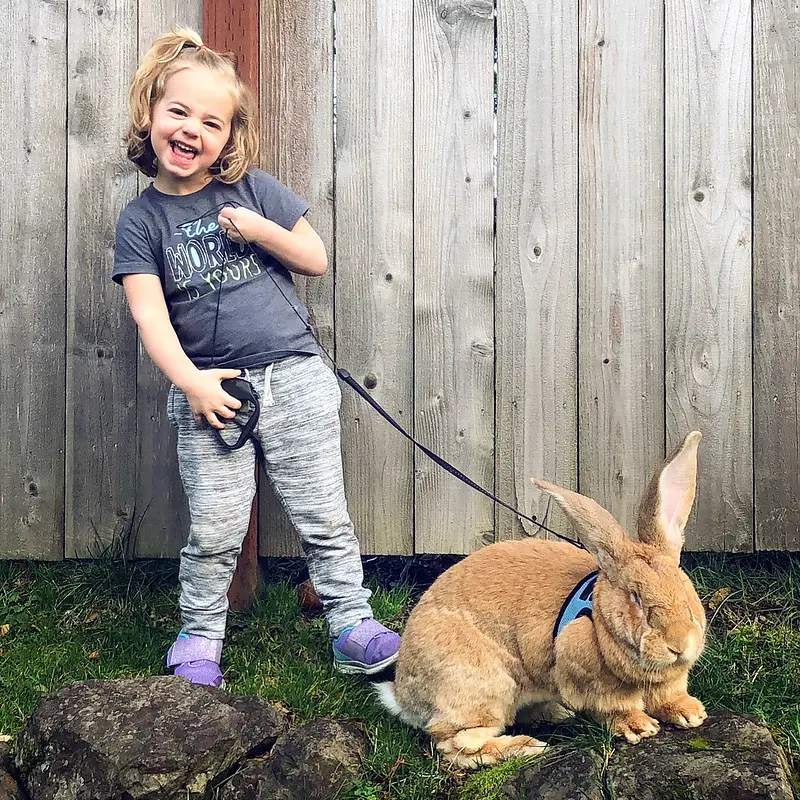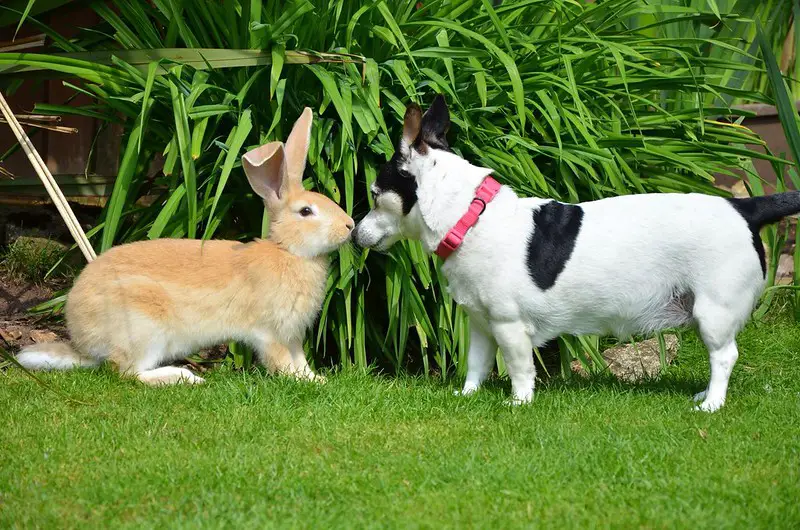Last Updated on June 12, 2023 by Laura Thompson
Continental Giant Rabbits are one of the largest and oldest rabbit breeds in the world. Also known as the German Giant Rabbit, they’re a huge favorite as pets and in rabbit shows due to their naturally docile nature. The Continental Giant bunny has also been known to be easy to train.
They can grow up to the size of an average human child and weigh over up to 25 pounds!
This makes them one of America’s biggest rabbits, but where did these giant bunnies come from?
In this article, we will discuss Continental Giant Bunnies including their origin, characteristics, behavior, and more.
Contents
- 1 History and Origin
- 2 Appearance of Continental Giant rabbits
- 3 Continental Giant Rabbit Colors
- 4 Continental Giant Rabbit Lifespan
- 5 Average Size of Continental Giant Rabbit
- 6 Continental Giant Rabbit Behavior and Temperament
- 7 Continental Giant Rabbits as Pets
- 8 How to Care for Your Continental Giant Rabbit?
- 9 The Diet of Continental Giant Rabbits
- 10 What do Continental Giant Rabbits eat?
- 11 What should you never feed your Continental Giant Rabbit?
- 12 Do Continental Giant Rabbits Need Cages?
- 13 Final Thoughts
History and Origin
One of the oldest and largest rabbit breeds, the Continental Giant rabbits date back to the 16th century.
Many descendants are Flemish Giants from Belgium but they also share a heritage with other popular breeds like Belgian Hare.
It wasn’t until 1893 when first standards for these giants were written after years of selective breeding in various countries across the EU including France, Italy, Germany, and more – explaining their wide range of sizes!
Appearance of Continental Giant rabbits
The Continental Giant is a rabbit that features an arch body type. This means the back will start at your shoulders and continue down to the base of your tail, giving you what we call “mandolin shape.”
The body of the Continental Giant must be powerful and long with muscular, broad hindquarters.
The power in the back end is matched by strength up front where they exhibit straighter forelegs as opposed to ones arched like those found on other breeds of rabbits.
Males will have a wide and large head, which is larger than the female.
Females will also feature an evenly spread dewlap that protrudes out from their chin.
And females should always have eyes open in order to look alert and attentive at all times of day or night; they are bright, round, and generally bigger-looking as well!
Continental Giant Rabbit Colors
The Continental Giant Rabbits have been recognized in two categories as colored and white.
The most common colors of Continental Giant bunnies are white and black.
However, some breeds have brown or piebald markings on their back, sides, ears, and tail tip.
The other common colors include:
- Light gray
- Steel gray
- Agouti
- Opal
- Yellow
- Black
- White
The Coat
A Continental Giant’s fur is glossy, dense, and thick.
The guard hairs are visible as well as the undercoat that feels soft to touch with a good amount of density too.
To make sure your rabbit stays clean you will need to groom them regularly or when they get older and have trouble keeping themselves tidy!
Continental Giant Rabbit Lifespan
Continental Giant Rabbits can live up to 4 to 7 years on average.
Average Size of Continental Giant Rabbit
A Continental Giant Rabbit is one of the largest breeds of rabbit.
They can grow to be anywhere from 24 to 28 inches in size and weigh up to 30 pounds!
The average weight for a Continental Giant Rabbit is generally around 20 pounds, with an approximate length of 18 inches.

Continental Giant Rabbit Behavior and Temperament
Continental Giant Rabbits are very social and docile animals. They tend to form strong bonds with their owner and have a tendency to be attention-seeking. Plus, they love to be petted and brushed. How adorable is that?
They are not aggressive by nature but will defend themselves if provoked. Though they’re not as active as smaller dwarf bunnies, they still like to play.
One thing to take note of is that Continental Giants in general don’t like to be carried and held. They also don’t like their feet to be touched.
Continental Giant Rabbits often groom each other as a means of establishing or maintaining dominance in the group.
Continental Giant Rabbits as Pets
Continental Giant Rabbits make great pets for people who have the time, space, and money for them. They are a lot of work, but they will give you back so much love in return!
They require lots of care: regular grooming, exercise outside of the cage once a day to get fresh air and some type of hideaway inside their cages.
Pros
- They are large animals and very cuddly.
- Continental Giant bunnies reproduce quickly, which means you can have a new rabbit in your home that is larger than the ones you see at pet stores within about six months!
- You don’t need to worry about them escaping because they aren’t as nimble or fast as other breeds (and will most likely not be able to jump over fences).
- The fur from these rabbits is very soft, making it an excellent option if you’re looking for something luxurious.
Cons
- They require a lot of space to move around and sleep in.
- They may not be suitable for beginners or first-time rabbit owners because they require very specific living conditions.
Those new to owning a Continental Giant Bunny should take into consideration the cost of food, bedding, shelter, and additional accessories like cages and playpens before bringing one home from an animal rescue organization or breeder.
How to Care for Your Continental Giant Rabbit?
Continental Giant Rabbits are gentle creatures that make for great companions. If you’re thinking about welcoming one into your home, here’s how to care for it!
The first thing you should do is feed the Continental Giant bunny and give it water while also feeding yourself. It can be a lot of work looking after a new pet, so don’t forget to take care of yourself too!

You should get their exercise with toys or by running around outside in an enclosed area like a garden.
They will need at least two hours free from caging every day because they love exploring and playing – just watch out for predators such as foxes when they’re outdoors on their own.
Health and Hygiene
Continentals are a healthy breed of rabbit in general, but they still have some risks that come with their size.
For example (and this is also common for smaller bunnies) sore hocks can be an issue if the bunny has insufficient flooring to move around on and these big ones really need the space!
They’ll develop it more quickly than other breeds because they’re so heavy.
Additionally, a rabbit’s house should never make up less than 1/4 square foot per pound. That means your own pet might only get half as much room as one who lives alone or shares its quarters with another smaller animal.
Continental Giant Rabbit Diet
The Diet of Continental Giant Rabbits
The Continental Giant Rabbits are herbivores, which means they only eat plants (vegetables).
A lot of their diet consists of hay, carrots, apples, and cabbage. The average-sized Continental Giant Rabbit can eat about 1/4 to 1/2 pounds of hay and vegetables per day.
What do Continental Giant Rabbits eat?
Continental Giant Rabbits are a large breed of rabbit. Hence, not only do they require more food than other breeds, but the amount required is even greater due to their size and bulkiness.
This makes Contis another pricey variety as it will cost you an arm and leg in comparison to less expensive rabbits per pound if not feed appropriately by weight to your veterinarian’s recommendations.
Hay
The best hay to offer, every day, for nursing, does and young kits is an Alfalfa/Timothy mix or Alfalfa/Orchard Grass mix.
Offering straight Alfalfa may be too rich which could cause unhealthy obesity in the kit.
Once the kits are ready to be weaned off of their mother’s milk they will need a milder Timothy-based diet so that they can maintain good health with high protein intake from pellets as well as the fiber content necessary for digestion.
Feed Your Continental Giant with Only the Best hay
If you’re looking for top-quality hay for your giant rabbit, here is a list of affordable hay from reputable brands for 2021.
Pellets
A rabbit’s diet is not solely based on the brand of pellets you use.
For example, it is important to remember that these items are fresh and contain the proper nutrients for your animals such as old-fashioned oats or gluten-free corn flakes with a mix of other dried fruits like raisins, prunes, cranberries, plus some occasional treats from time to time.
What really matters about feeding rabbits well and having more fiber in their diets than most pets have is because this type of food benefits gut mobility and intestinal functions.
An essential part of health problems related bloat which can happen when there isn’t enough fiber present!
Vegetables and Fruits
Fruits and vegetables that can be fed to your Continental Giant Rabbits include:
- Kale
- Spinach
- Oats
- Barley
- Black Oil Sunflower Seeds
- Dandelion Greens
- Apples
- Bananas
- Strawberries
- Raspberries
- Sweet Potato
- Beet Tops
- Carrots
- Romaine Lettuce
- Papaya
- Pumpkin
- Parsley
- Pineapple
- Bell Peppers
- Clover
- Watercress
- Grapes
- Grapevine leaves
- Bok Choy
- Cucumber
- Tomato
- Cheerios
- Shredded Wheat
- Zucchini
Fresh water
Keeping your Continental Giant rabbit hydrated is crucial. Keep pure and fresh water in a place where your rabbit can access easily, whenever they feel thirsty.
What should you never feed your Continental Giant Rabbit?
There are some food items that can harmful to your Continental Giant rabbits.
Some of these food items include:
- Chocolate
- White Potato
- Rice
- Sugary or Starchy Foods
Do Continental Giant Rabbits Need Cages?
Due to their size, living in a wire cage may not be suitable for your Continental Giant. Rabbit housing with steps and wire flooring is also not good for these giant rabbits.
They need large housing and plenty of space to move around and play. In this case, a playpen might be more comfortable for your gentle giant.
Find a Big Playpen for Your Continental Giant Rabbit
These gentle giants won’t do well in cages or average-sized hutches. Instead, get them a big playpen instead! We have an updated list of the best playpens here for your Continental Giant for 2021.
There are some owners that let their pets roam about the house. Though this is risky because they can get into a lot of trouble with electrical cords and other household items.
A playpen will keep your Continental Giant bunny in one place while still giving them plenty to explore within its walls.
It’ll also help you maintain order by keeping all toys and pellets on one level rather than strewn across the whole room like confetti!
Final Thoughts
If you’re looking for a new pet, and have always wanted to have an animal that’s bigger than your cat or small dog, then the Continental Giant Rabbit is perfect.
They make great pets because they are very friendly animals with large personalities. Plus, they’re easy to train!
Laura is an experienced wildlife rehabilitator and conservationist residing in Madison, Wisconsin. Her love for rabbits was sparked during her early career when she nursed an injured wild rabbit back to health. Today, she runs “Hoppy Haven”, a rehabilitation center dedicated to the care and release of injured wild rabbits.
